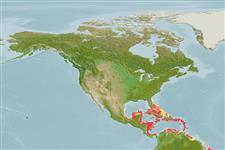Environment: milieu / climate zone / Tiefenbereich / distribution range
Ökologie
seewasser demersal. Tropical
Western Atlantic: the Bahamas, Leeward Islands and the western Caribbean (Ref. 5521). Antilles (Ref. 26938).
Size / Gewicht / Alter
Geschlechtsreife: Lm ? range ? - ? cm
Max length : 9.0 cm TL Männchen/unbestimmt; (Ref. 5521)
Rückenflossenweichstrahlen (insgesamt) : 10 - 11; Afterflossenweichstrahlen: 10 - 12. Body depth at base of pelvic fin. Scales moderate, pectoral axillary moderate in size (Ref. 39156).
Body shape (shape guide): elongated.
Inhabits coral reef and sandy bottoms (Ref. 5521).
Life cycle and mating behavior
Geschlechtsreife | Fortpflanzung | Ablaichen | Eier | Fecundity | Larven
Böhlke, J.E. and C.C.G. Chaplin, 1993. Fishes of the Bahamas and adjacent tropical waters. 2nd edition. University of Texas Press, Austin. (Ref. 5521)
IUCN Rote Liste Status (Ref. 130435: Version 2025-1)
Bedrohung für Menschen
Harmless
Nutzung durch Menschen
Tools
Zusatzinformationen
Download XML
Internet Quellen
Estimates based on models
Preferred temperature (Ref.
123201): 27 - 28.2, mean 27.7 °C (based on 409 cells).
Phylogenetic diversity index (Ref.
82804): PD
50 = 0.5000 [Uniqueness, from 0.5 = low to 2.0 = high].
Bayesian length-weight: a=0.00501 (0.00236 - 0.01065), b=3.10 (2.93 - 3.27), in cm total length, based on LWR estimates for this Genus-body shape (Ref.
93245).
Trophic level (Ref.
69278): 3.6 ±0.3 se; based on size and trophs of closest relatives
Widerstandsfähigkeit (Ref.
120179): hoch, Verdopplung der Population dauert weniger als 15 Monate. (Preliminary K or Fecundity.).
Fishing Vulnerability (Ref.
59153): Low vulnerability (10 of 100).
🛈
